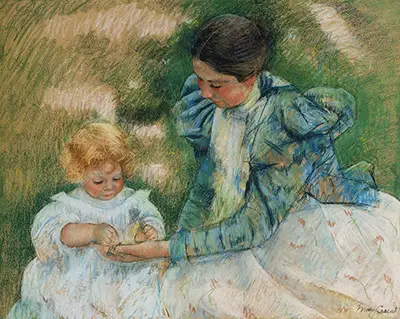 Buy Art Prints Now
Buy Art Prints Nowfrom Amazon
* As an Amazon Associate, and partner with Google Adsense and Ezoic, I earn from qualifying purchases.
Mother Playing with Child is a pastel artwork by Mary Cassatt which dates from 1897 and can now be found in the collection of the Metropolitan Museum of Art in the US. The theme is entirely typical of this famous artist.
The scene here features mother and child playing outdoors together in either a garden or local park. Cassatt deliberately keeps the background vague in order to direct our focus exclusively on the two figures in the foreground. The atmosphere is relaxed and perhaps they are playing with some small flower petals, as the mother opens her hand and plays along with whatever the child is doing. Both are smartly dressed, reflecting that this is not another of the artist’s domestic scenes and so they have smartened up before going out in public. Both sport light coloured dresses, but the top half of the mother's outfit is a blue tone, with opaque frills around the shoulders. The scene behind is predominantly green grass with some bare areas in which a sandy colour shows through.
It is important to place this artwork within the overall context of Cassatt's career, namely that she had been working intensely within the pastel medium throughout the 1890s in conjunction with her close friend and colleague, Edgar Degas. They both loved the colours brought about by using pastels and their respective contributions helped to gain a greater respect from others for pastel drawing as an artistic discipline. Degas himself was also highly skilled in oils as well, just as was Cassatt, but his oeuvre included different content to a certain degree. There was not the plethora of mother and child portraits as delivered by his friend, but instead some other genres such as portraits of ballerinas on stage and in dance classes as well as scenes from 19th century horse race meetings.
Degas would encourage others to practice obsessively, in some cases removing any chance occurrences within any of his artworks. This is understandable within the challenging discipline of portraiture but slightly flew in the face of other Impressionists who enjoyed artworks which grew organically and felt this better reflected their expressive tendencies. Cassatt deeply respected Degas and so did take some of his advice onboard but she was also highly self-confident, perhaps as a direct result from her own privileged background, and so would not have felt obliged to take on any more of his ideas that just those that made sense to her at the time.




